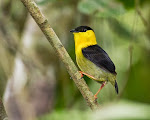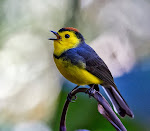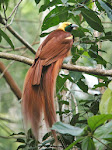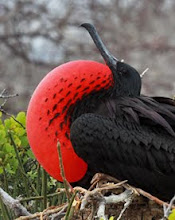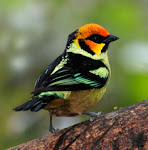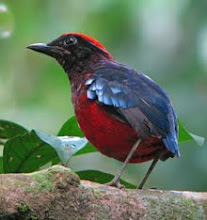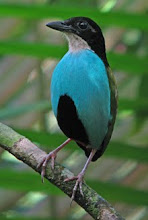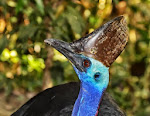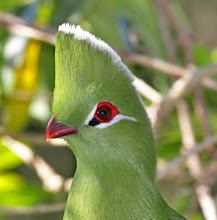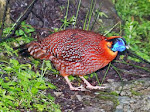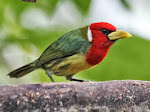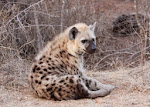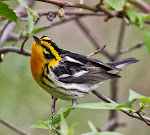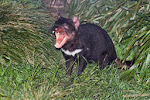Departing in darkness we made it to a steep hillside, which we did not exactly fly up, but with the promise of one of the World's best birds, Blue Bird-of-paradise, possibly waiting near the end our pace was a little quicker than it might have been! After a nail-biting wait a full streamered male flew in and brought gasps all around. All were in agreement; it IS one of the world's best birds.
In the afternoon we planned to visit the large mountain garden our local guide, who offered such delectable birds as Sooty Melidectes, Crested Satinbird (formerly Crested Bird-of-paradise), Dusky Woodcock and Crested Berrypecker. I mean, how could we resist with such an illustrious set of birds on offer?! We lunched at Kumul Lodge, with regular bird table companions such as Belford's Melidectes, Brehm's Tiger-Parrots for company. The orange blooms alongside shook with the visit of a scarlet and jet black male Red-collared Myzomela too, while a young White-winged Robin regularly launched attacks on insects from the legs of the bird table.
After lunch we departed for the mountain garden, which comprised of a large area of crops and natural grassland, surrounded by thick, mountain forest. Unfortunately, as we made our way to the area with our guide, Max, the heavens opened, and heavy rain began to fall. Undeterred, we continued to the site, arrived at the clearing, but quickly needed to take shelter under the eaves of Max's traditional hut. The rain was heavy and the clouds so low we could barely make out the trees at the edge of the clearing. Unsurprisingly, some of the group, feeling the chill and seeing little to promise of a change in the weather, headed back to the lodge for the remainder of the afternoon. Foolishly, it appeared, Chris and myself decided, with no further afternoons available to visit this spot, to stick it out until late afternoon and hope for a change in circumstances. Several hours passed, and then finally, the clouds lifted and the trees became visible once more, even if light rain continued to fall. We left the shelter of the hut, and made our way across the clearing to a large dense fruiting tree, where a movement led us to the first of our targets: Crested Berrypecker, which looks rather like a strange waxwing, but daubed in blue-and-white! We were pumped. Several hours in the cold, relentless rain had paid off after all. But the best was yet to come. Another rustle in the trees led us to a female Crested Satinbird. It may have been only the dowdy female version, but we had the bird for the first time on the trip and we were happy. Then Max alerted us to the first of three Sooty Melidectes which visited some blooms of white flowers in the clearing. Amazingly, this species has only recently been discovered in the area, with regular sightings only coming from this spot during this year only. We got some great scope looks as the rain began to finally let up. We shook off our umbrellas and soon after heard the calls of a MALE Crested Satinbird emanating from near the fruiting tree that had hosted both the Crested Berrypeckers and the female of this species. Incredibly, and dramatically a large fiery orange bird appeared in the tree. We had barely clapped eyes on this jet black and orange male Crested Satinbird, when it jumped up and landed on the crown of the tree, as if to say "have you got me now!!!" We could not have dared to dream of a better outcome to the afternoon which begun oh so poorly, with rain lashing down, and near zero visibility. Chris and I were flushed with our success and were beaming, and thankful that our long, and cold, wait in the rain had been very worthwhile. We decided to wait until dusk, and see if the hoped for Dusky Woodcock (a lifer for myself even on my 7th tour of PNG), would rode over the clearing. Amazingly, a short time after light had begun to fade, the distinctive calls of a woodcock drifted across the clearing to our ears, and moments later the woodcock was seen as it flew across a large gap in the forest. Life was chipper after a truly amazing afternoon, which will live long in my memory for sure! Once again it was proved to me that mountain weather is completely unpredictable from what your eyes see, and that the birds that live there are equally unpredictable. Something that makes birding so exciting.
More from PNG to come...



















































